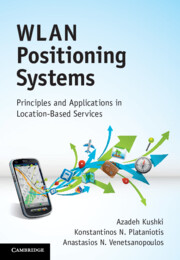10 - The road ahead
from Part II - Signal processing theory
Published online by Cambridge University Press: 05 February 2012
Summary
Since the first WLAN-positioning system was introduced in 2000 [4], rapid advances in signal processing methods have been made in this area. A decade later, fundamental positioning techniques have matured significantly, allowing these systems to offer highly accurate positioning estimates with accuracies on the order of several meters in both indoor and outdoor environments.
The previous chapters have reviewed the fundamental techniques used in WLAN positioning. In this chapter, we look ahead to opportunities and challenges remaining to be addressed in this area.
Highlights
The focus of this book has been WLAN-based positioning. Chapters 1 to 4 discussed the history, applications, and various positioning systems to motivate these systems. In particular, the development of these systems is motivated by the need for accurate, reliable, and cost-efficient positioning solutions to enable the delivery of location-based services (LBS).
The second part of the book was dedicated to fundamental signal processing concepts in these systems. In Chapter 5, we saw that the unpredictability of radio signal features poses a significant challenge to the development of accurate and reliable WLAN systems. In Chapter 6, we discussed a number of non-parametric techniques that can be used to model these radio signals using training samples collected at a set of anchor points with known locations. In addition to their effectiveness as modeling tools, these nonparametric techniques also allowed the estimation of a measure of uncertainty associated with position estimates.
- Type
- Chapter
- Information
- WLAN Positioning SystemsPrinciples and Applications in Location-Based Services, pp. 136 - 140Publisher: Cambridge University PressPrint publication year: 2012



